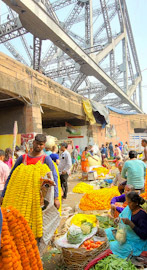Blooms beneath a bridge in the city of Calcutta
OVERLOOKED BY THE MIGHTY Howrah Bridge and straggling alongside the left bank of the Hooghly River – a stretch of the Ganges – you will find the colourful Mullick Ghat flower market. The best way to enter this busy marketplace is by descending a staircase at the southeast corner of the Howrah Bridge (completed 1943). As you go down the stairs, you will have to step aside to make way for men carrying enormous, heavy loads on their heads. Many of them make use of the stair rails to support themselves while they climb.

Part of the flower market (next to the railway track) is in the open air. The rest of it – the part nearest to the river – is under cover. Narrow, muddy passages run between the numerous stalls selling whole flowers, flower heads, individual flower parts, and petals. Also, flower garlands and other floral decorations are aplenty. A steady stream of people hurry in all directions along these paths. Many of them are carrying heavy head loads. Occasionally, they dump the head loads (containing floral items) at one stall or another. To an outsider, like me, the place seems like a chaotic but highly colourful environment. It is probably not as crazy as it seems, but highly organised.
The flower market was established along this part of the Hooghly during or before the 19th century (https://www.telegraphindia.com/my-kolkata/places/a-visit-to-mullick-ghat-flower-market-one-of-asias-largest-under-the-howrah-bridge-in-kolkata/cid/1892065). The ghat was built in 1855 by Rammohan Mullick in honour of his father Nimai Charan Mullick. It was constructed on the land where the old Noyaner Ghat had stood. The older landing stage had been made by Noyanchand Mullick in 1793.
The Mullick Ghat stands next to the Jagganath Ghat, which was constructed in 1760. Both ghats were important because they were used by pilgrims embarking on ships to transport them to the holy site at Puri in Orissa. Although it is not known for certain why the flower market was established beside these ghats, it is not unlikely that it was connected to the embarkation places for the pilgrims. And flowers play an important role in Hindu rituals.
Even though the market seemed extremely busy to me, it is apparently in decline. This was in no little way connected with the recent covid19 pandemic. If what I saw is a somewhat diminished version of the market, I can barely imagine what it must have been like a few years ago. Providing you are not allergic to pollen or crowds, a visit to the flower market is an exciting and beautiful experience.



